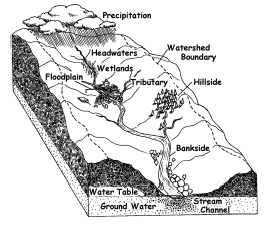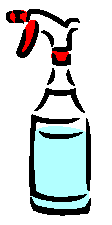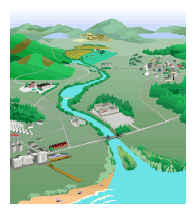Water: Middle School
Exercise III. Making a Model Watershed
 (Adapted from National Geographic Web education modules at http: //magma .national geographic .com /education
(Adapted from National Geographic Web education modules at http: //magma .national geographic .com /education
/gaw /frwater /frwater _912_ teacher .html#top
)
Materials Needed
Each group of students will need:
- Bucket
- Blue marker
- Aluminum foil
- Water in a sprinkling can or spray bottle
- Shallow washbasin or dishpan
- Large and small rocks, chunks of wood, and/or boxes
Procedure
 In the shallow basin, arrange rocks, wood, or boxes higher on one end of the basin than on the other. Cover the rocks with aluminum foil, pressing the foil against the rocks to create a miniature landscape within the washbasin. Make sure the edges of the foil remain inside the tub-or you'll create a waterfall! Your model should look like you filled a basin to the rim with lumpy mashed potatoes, then shoved half the potatoes to one end into a lumpy mountain. Make different folds, routes, ridges, and valleys to force the "rainwater" to flow down different paths. Use a blue marker to draw the place where you believe the main rivers will flow.
In the shallow basin, arrange rocks, wood, or boxes higher on one end of the basin than on the other. Cover the rocks with aluminum foil, pressing the foil against the rocks to create a miniature landscape within the washbasin. Make sure the edges of the foil remain inside the tub-or you'll create a waterfall! Your model should look like you filled a basin to the rim with lumpy mashed potatoes, then shoved half the potatoes to one end into a lumpy mountain. Make different folds, routes, ridges, and valleys to force the "rainwater" to flow down different paths. Use a blue marker to draw the place where you believe the main rivers will flow.
Once your teacher gives you the word, use the spray bottle to make it "rain" over the land. Observe what happens when it rains. Once you have written down your observations, remove the foil from the rocks, remove the rocks from the tub, and empty the "rainwater" into a bucket.
Observations
Fun Facts About Water
In a 100-year period, a water molecule spends 98 years in the ocean, 20 months as ice, about 2 weeks in lakes and rivers, and less than 1week in the atmosphere.
All the freshwater flowing in rivers and held in lakes is only 1 percent of the water on Earth.
There is the same amount of water on Earth as there was when Earth was formed. The water from your faucet could contain molecules that dinosaurs drank.
The bathroom is the room in the house where the most water is used.
What happens to the water as it begins to rain?
How do streams form?
How many streams form?
Where do they form?
Where does all the water end up after the rainstorm?
Analysis
Where do streams form?
How many watersheds drained into your main river?
What caused the water to flow in a certain direction?
Where were the first-order streams located in your watershed?
What happened to your main river as other streams joined it?
If this were a real watershed, where would all the water end up at the conclusion of the experiment?
Conclusions

Write a brief paragraph about how water collects in a watershed.
Middle Schools | Whatzzzup_Stream? | Exercises: I | II | III | IV | V | VI | Top
